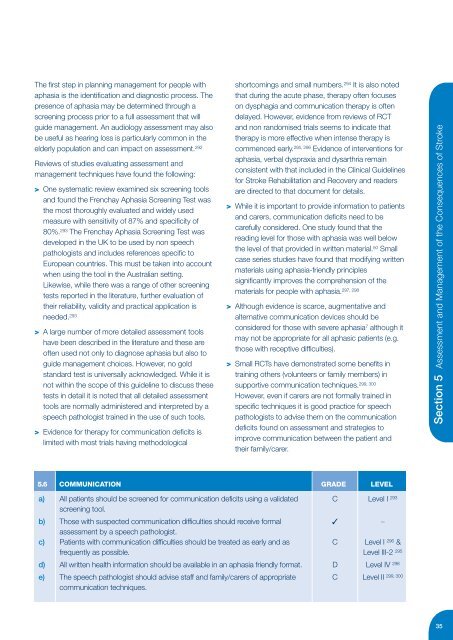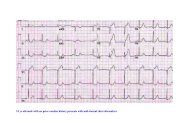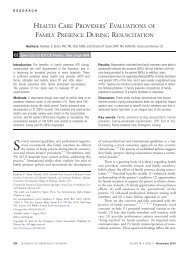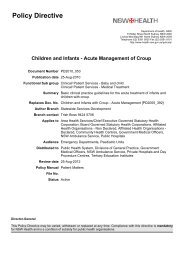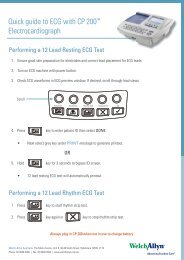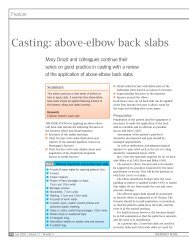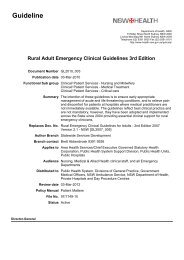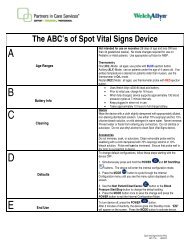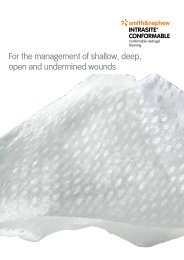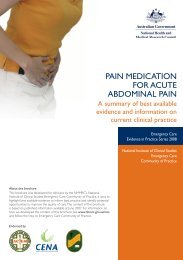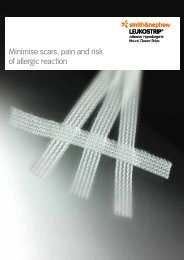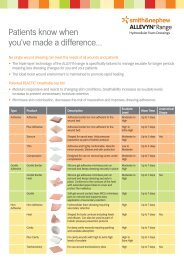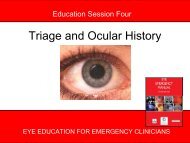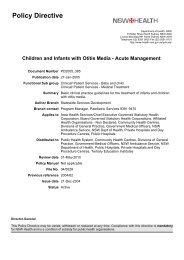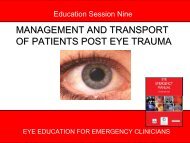Clinical Guidelines for Acute Stroke Management - Living on the EDge
Clinical Guidelines for Acute Stroke Management - Living on the EDge
Clinical Guidelines for Acute Stroke Management - Living on the EDge
Create successful ePaper yourself
Turn your PDF publications into a flip-book with our unique Google optimized e-Paper software.
The first step in planning management <str<strong>on</strong>g>for</str<strong>on</strong>g> people with<br />
aphasia is <strong>the</strong> identificati<strong>on</strong> and diagnostic process. The<br />
presence of aphasia may be determined through a<br />
screening process prior to a full assessment that will<br />
guide management. An audiology assessment may also<br />
be useful as hearing loss is particularly comm<strong>on</strong> in <strong>the</strong><br />
elderly populati<strong>on</strong> and can impact <strong>on</strong> assessment. 292<br />
Reviews of studies evaluating assessment and<br />
management techniques have found <strong>the</strong> following:<br />
> One systematic review examined six screening tools<br />
and found <strong>the</strong> Frenchay Aphasia Screening Test was<br />
<strong>the</strong> most thoroughly evaluated and widely used<br />
measure with sensitivity of 87% and specificity of<br />
80%. 293 The Frenchay Aphasia Screening Test was<br />
developed in <strong>the</strong> UK to be used by n<strong>on</strong> speech<br />
pathologists and includes references specific to<br />
European countries. This must be taken into account<br />
when using <strong>the</strong> tool in <strong>the</strong> Australian setting.<br />
Likewise, while <strong>the</strong>re was a range of o<strong>the</strong>r screening<br />
tests reported in <strong>the</strong> literature, fur<strong>the</strong>r evaluati<strong>on</strong> of<br />
<strong>the</strong>ir reliability, validity and practical applicati<strong>on</strong> is<br />
needed. 293<br />
> A large number of more detailed assessment tools<br />
have been described in <strong>the</strong> literature and <strong>the</strong>se are<br />
often used not <strong>on</strong>ly to diagnose aphasia but also to<br />
guide management choices. However, no gold<br />
standard test is universally acknowledged. While it is<br />
not within <strong>the</strong> scope of this guideline to discuss <strong>the</strong>se<br />
tests in detail it is noted that all detailed assessment<br />
tools are normally administered and interpreted by a<br />
speech pathologist trained in <strong>the</strong> use of such tools.<br />
> Evidence <str<strong>on</strong>g>for</str<strong>on</strong>g> <strong>the</strong>rapy <str<strong>on</strong>g>for</str<strong>on</strong>g> communicati<strong>on</strong> deficits is<br />
limited with most trials having methodological<br />
shortcomings and small numbers. 294 It is also noted<br />
that during <strong>the</strong> acute phase, <strong>the</strong>rapy often focuses<br />
<strong>on</strong> dysphagia and communicati<strong>on</strong> <strong>the</strong>rapy is often<br />
delayed. However, evidence from reviews of RCT<br />
and n<strong>on</strong> randomised trials seems to indicate that<br />
<strong>the</strong>rapy is more effective when intense <strong>the</strong>rapy is<br />
commenced early. 295, 296 Evidence of interventi<strong>on</strong>s <str<strong>on</strong>g>for</str<strong>on</strong>g><br />
aphasia, verbal dyspraxia and dysarthria remain<br />
c<strong>on</strong>sistent with that included in <strong>the</strong> <str<strong>on</strong>g>Clinical</str<strong>on</strong>g> <str<strong>on</strong>g>Guidelines</str<strong>on</strong>g><br />
<str<strong>on</strong>g>for</str<strong>on</strong>g> <str<strong>on</strong>g>Stroke</str<strong>on</strong>g> Rehabilitati<strong>on</strong> and Recovery and readers<br />
are directed to that document <str<strong>on</strong>g>for</str<strong>on</strong>g> details.<br />
> While it is important to provide in<str<strong>on</strong>g>for</str<strong>on</strong>g>mati<strong>on</strong> to patients<br />
and carers, communicati<strong>on</strong> deficits need to be<br />
carefully c<strong>on</strong>sidered. One study found that <strong>the</strong><br />
reading level <str<strong>on</strong>g>for</str<strong>on</strong>g> those with aphasia was well below<br />
<strong>the</strong> level of that provided in written material. 50 Small<br />
case series studies have found that modifying written<br />
materials using aphasia-friendly principles<br />
significantly improves <strong>the</strong> comprehensi<strong>on</strong> of <strong>the</strong><br />
materials <str<strong>on</strong>g>for</str<strong>on</strong>g> people with aphasia.<br />
297, 298<br />
> Although evidence is scarce, augmentative and<br />
alternative communicati<strong>on</strong> devices should be<br />
c<strong>on</strong>sidered <str<strong>on</strong>g>for</str<strong>on</strong>g> those with severe aphasia 7 although it<br />
may not be appropriate <str<strong>on</strong>g>for</str<strong>on</strong>g> all aphasic patients (e.g.<br />
those with receptive difficulties).<br />
> Small RCTs have dem<strong>on</strong>strated some benefits in<br />
training o<strong>the</strong>rs (volunteers or family members) in<br />
supportive communicati<strong>on</strong> techniques.<br />
299, 300<br />
However, even if carers are not <str<strong>on</strong>g>for</str<strong>on</strong>g>mally trained in<br />
specific techniques it is good practice <str<strong>on</strong>g>for</str<strong>on</strong>g> speech<br />
pathologists to advise <strong>the</strong>m <strong>on</strong> <strong>the</strong> communicati<strong>on</strong><br />
deficits found <strong>on</strong> assessment and strategies to<br />
improve communicati<strong>on</strong> between <strong>the</strong> patient and<br />
<strong>the</strong>ir family/carer.<br />
Secti<strong>on</strong> 5 Assessment and <str<strong>on</strong>g>Management</str<strong>on</strong>g> of <strong>the</strong> C<strong>on</strong>sequences of <str<strong>on</strong>g>Stroke</str<strong>on</strong>g><br />
5.6 COMMUNICATION GRADE LEVEL<br />
a) All patients should be screened <str<strong>on</strong>g>for</str<strong>on</strong>g> communicati<strong>on</strong> deficits using a validated C Level I 293<br />
screening tool.<br />
b) Those with suspected communicati<strong>on</strong> difficulties should receive <str<strong>on</strong>g>for</str<strong>on</strong>g>mal ✓ –<br />
assessment by a speech pathologist.<br />
c) Patients with communicati<strong>on</strong> difficulties should be treated as early and as C Level I 296 &<br />
frequently as possible. Level III-2 295<br />
d) All written health in<str<strong>on</strong>g>for</str<strong>on</strong>g>mati<strong>on</strong> should be available in an aphasia friendly <str<strong>on</strong>g>for</str<strong>on</strong>g>mat. D Level IV 298<br />
e) The speech pathologist should advise staff and family/carers of appropriate C Level II<br />
299, 300<br />
communicati<strong>on</strong> techniques.<br />
35


